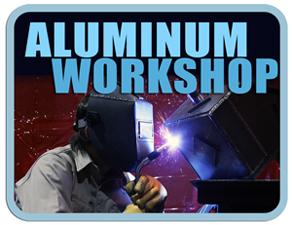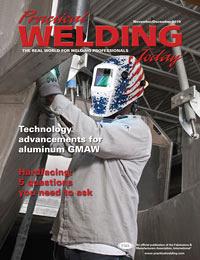President
- FMA
- The Fabricator
- FABTECH
- Canadian Metalworking
Categories
- Additive Manufacturing
- Aluminum Welding
- Arc Welding
- Assembly and Joining
- Automation and Robotics
- Bending and Forming
- Consumables
- Cutting and Weld Prep
- Electric Vehicles
- En Español
- Finishing
- Hydroforming
- Laser Cutting
- Laser Welding
- Machining
- Manufacturing Software
- Materials Handling
- Metals/Materials
- Oxyfuel Cutting
- Plasma Cutting
- Power Tools
- Punching and Other Holemaking
- Roll Forming
- Safety
- Sawing
- Shearing
- Shop Management
- Testing and Measuring
- Tube and Pipe Fabrication
- Tube and Pipe Production
- Waterjet Cutting
Industry Directory
Webcasts
Podcasts
FAB 40
Advertise
Subscribe
Account Login
Search
Aluminum Workshop: Common porosity problems (and how to fix them)
- By Frank Armao
- November 26, 2014
- Article
- Aluminum Welding
Q: I’m having a lot of problems with porosity in my aluminum welds. Can you tell me what’s causing it?
A: As we’ve said before, all porosity in aluminum welds is caused by hydrogen, which is very soluble in molten aluminum but insoluble in solid aluminum. Generally, hydrogen comes from two sources—water vapor and residual hydrocarbons, which are usually residual oils, greases, lubricants, or solvents. So where specifically should you look? Following are some of the culprits and how to correct them.
- Residual water in the shielding gas. Remember, the dew point of the gas should be -76 F or lower.
- Incorrect contact tip-to-work distance. Give yourself a contact tip-to-work distance of about 15 mm. Any longer than 15 mm can let air into the shielding gas blanket.
- Contamination on the plate surface. This usually is caused by oils and greases. You need to remove these with a good degreasing solvent. Wire brushing alone will not remove them.
- Incorrect gun angle. Always use a push angle, and never drag the torch.
- Incorrect shielding gas flow rate. Use at least 35 SCFH for GMAW and 25 SCFH for GTAW.
- Spatter buildup in the gun nozzle. Even a small amount can disturb the gas flow and cause porosity. Keep it clean.
- Small gas nozzle. Try using a larger nozzle.
- Antispatter sprays on aluminum or on the welding torch. Never use them, as these products contain hydrocarbons.
- Filler wire with residual drawing lubricant on it. Try a different spool of wire.
- Aluminum storage environment. If the aluminum is stored outside and moved into a warm shop, you may get water condensing on it.
- Water leakage in a water-cooled torch. This will cause porosity long before you can visually detect the leak.
- Drafty welding area. This can blow away the shielding very easily. If you can feel a breeze in the area, that’s too much. Turn off all fans in the area.
I have listed these in random order. Some are common, some are not (for instance, bad shielding gas and bad filler wire). However, I will end by making an emphatic statement: The welding power source cannot cause porosity unless there is a water leak in the torch.
About the Author

Frank Armao
Aluminum Consulting Inc.
440-479-0239
About the Publication
Related Companies
subscribe now

The Welder, formerly known as Practical Welding Today, is a showcase of the real people who make the products we use and work with every day. This magazine has served the welding community in North America well for more than 20 years.
start your free subscription- Stay connected from anywhere

Easily access valuable industry resources now with full access to the digital edition of The Fabricator.

Easily access valuable industry resources now with full access to the digital edition of The Welder.

Easily access valuable industry resources now with full access to the digital edition of The Tube and Pipe Journal.
- Podcasting
- Podcast:
- The Fabricator Podcast
- Published:
- 04/16/2024
- Running Time:
- 63:29
In this episode of The Fabricator Podcast, Caleb Chamberlain, co-founder and CEO of OSH Cut, discusses his company’s...
- Trending Articles
Sheffield Forgemasters makes global leap in welding technology

Welding student from Utah to represent the U.S. at WorldSkills 2024

Lincoln Electric announces executive appointments

Lincoln Electric acquires RedViking

Engine-driven welding machines include integrated air compressors

- Industry Events
16th Annual Safety Conference
- April 30 - May 1, 2024
- Elgin,
Pipe and Tube Conference
- May 21 - 22, 2024
- Omaha, NE
World-Class Roll Forming Workshop
- June 5 - 6, 2024
- Louisville, KY
Advanced Laser Application Workshop
- June 25 - 27, 2024
- Novi, MI



























